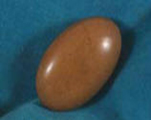The Dallas Morning News of February 28, 1892 ran the following item, “Five children on the farm of J. C. Bomar were bitten by a rabid dog. All the children were taken to Greenville (Texas) to try the efficacy of a madstone.” Fortunate were the people in Greenville and other communities in the South where a madstone was available.
There is some argument as to what the madstone was. Some believed it was made of herbs, porous wood, calcined bone or a smooth stone. Most historians and folk medicine experts believe that madstone was actually a bezoar: a substance similar to a gallstone found in ruminant animals such as deer, cattle, or goats. It consisted of animal fur, plant stalks, and other indigestible matter the animal had eaten. Those found in the stomach of a white deer were the most valuable.
The treatment was always the same. The victim’s wound was thoroughly washed. The madstone was soaked in warm milk for a couple of minutes before being placed on the wound. If it stuck to the wound, the wound surely contained poison. The white or cream colored stone turned to nauseous green. At that point, the madstone was removed, rinsed in boiling water to remove the poison, and again soaked in warm milk. The process was repeated until the stone no longer stuck to the wound or turned green.
The earliest mention of a madstone in Virginia was the Fauquier madstone, owned by James Smith of Scotland in the 1600’s.

